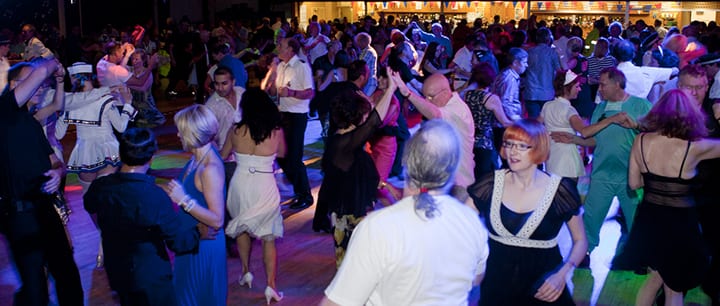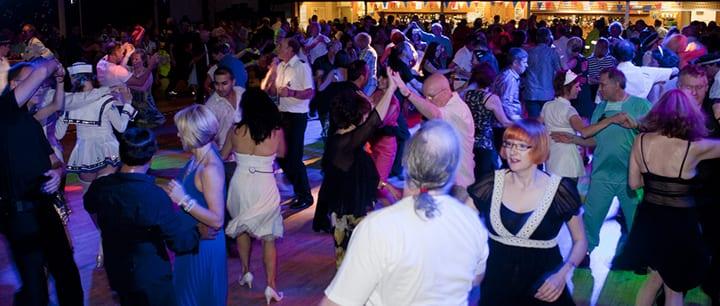 For almost a century, swing dancing has attracted enthusiastic, carefree, and highly musical people from all walks of life. If you love its unrestrained movements and nostalgic charm, here are five interesting facts to know before you hit the dance floor.
For almost a century, swing dancing has attracted enthusiastic, carefree, and highly musical people from all walks of life. If you love its unrestrained movements and nostalgic charm, here are five interesting facts to know before you hit the dance floor.
1. Swing dance goes by many names
Swing belongs to the jazz school of dance, but the term doesn’t apply to one single technique. There are several distinct swing styles, and they each developed alongside shifting musical and cultural trends.
- Lindy Hop — a reference to Charles Lindbergh’s historic transatlantic flight in 1927; danced within a designated space but highly social and creative
- Savoy-style Lindy Hop — distinguished by more upbeat, circular movements
- Collegiate Shag — chest-to-chest dancing with alternating feet (one foot goes between partner’s feet), to uptempo jazz music
- St. Louis shag — side-by-side dancing with forward kicks and stomps
2. Swing is dancing’s greatest equalizer
If dances were people, swing would be a civil rights pioneer. When it first emerged in the United States in the 1920s, nothing else brought New Yorkers–of all ethnic traditions–together in quite the same way.
While racial segregation continued to divide and oppress throughout the country, it didn’t apply in Harlem’s Savoy Ballroom. That’s where European-style partner dancing began to merge with the unique styles associated with traditional African dances, as well as African-American dances like Juba (also known as hambone) and tap. This combination of formal and celebratory traditions resulted in the wide-legged, synchronized, energetic styles that still characterize modern swing.
Swing also played a part in shattering gender stereotypes, long before the idea of feminism was coined. During World War II, both soldiers and civilians spent their downtime practicing the wildly popular dance, allowing them to socialize and distract themselves in a lighthearted setting. Suddenly, it no longer mattered whether a man was leading a woman through the steps. With so many men overseas, same-sex swing pairs became increasingly common. Women learned to lead, men learned to follow, and there were few reservations about these alternative roles. Today, you’ll find the same open-minded attitude prevails in swing dancing clubs and competitions.
3. Competitions are divided into categories
As you learn to swing dance and begin to master the fundamentals, you might decide to enter a competition. The following categories will determine the rules you’ll need to follow:
4. Swing dancers don’t always pair off
When most people think of swing, they imagine dancers pairing off to perform synchronized footwork to energetic, old-school music. However, you can also learn to swing dance alone, or with a large group of people. It’s incorporated into many modern and contemporary jazz routines, in which groups of dancers synchronize their swings, bounces, and taps in a wide variety of creative patterns.
Individual routines are also more commonplace than you’d think, and they’ve always been an important part of swing’s evolution. In fact, one example of a solo swing dance–the Charleston–became a fame-making move for Hollywood stars like Dean Collins and Josephine Baker. Whether you learn the Lindy Hop or Swinging Charleston, the basics are the same: an eight-step sequence of fast-kicking, foot-tapping dance moves that take you backwards and forwards in quick succession.
5. Swing is a celebration of life, music, and movement
Do you often hear that you’re “full of life” because your enthusiasm is so unbridled and contagious? Do you find it difficult to contain your joy when you’re having a great day, or keep your feet and hands from moving to the beat when your favorite song comes on? If so, you should definitely learn to swing dance!
To emulate the greats and swing dance on a competitive level, you need happy hands and feet that can keep up with fast-paced, upbeat music. It’s not just about following the right footwork patterns or exaggerating your movements; swing dance is a celebration of life and music. An open mind and passion for music will help you embrace the exciting world of swing.
Of course, an understanding of the fundamentals of swing is important for all beginners to learn. You may be able to pick up some techniques from watching others dance, but working one-on-one with a dance teacher will take you much further. Ready to get started? Find an instructor near you to help you perfect the techniques, make sure your timing is right, and gain the confidence you need to dance with enthusiasm and passion. Good luck, and remember to have fun!
Photo by Jive Addiction
Suzy S.

